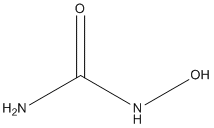
Hydroxyurea (NSC-32065) is an antineoplastic agent that inhibits DNA synthesis through the inhibition of ribonucleoside diphosphate reductase. Hydroxyurea is converted to a free radical nitroxide (NO) in vivo, and transported by diffusion into cells where it quenches the tyrosyl free radical at the active site of the M2 protein subunit of ribonucleotide reductase, inactivating the enzyme. The entire replicase complex, including ribonucleotide reductase, is inactivated and DNA synthesis is selectively inhibited, producing cell death in S phase and synchronization of the fraction of cells that survive. Repair of DNA damaged by chemicals or irradiation is also inhibited by hydroxyurea, offering potential synergy between hydroxyurea and radiation or alkylating agents. Hydroxyurea also increases the level of fetal hemoglobin, leading to a reduction in the incidence of vasoocclusive crises in sickle cell anemia. Levels of fetal hemoglobin increase in response to activation of soluble guanylyl cyclase (sGC) by hydroxyurea-derived NO.
| Cell Experiment | |
|---|---|
| Cell lines | Erythroid cells |
| Preparation method | Obtain erythroid cells from peripheral blood of the same patients(Thirteen β-Thal/HbE patients which are treated with hydroxyurea orally for 2 years at a starting dose of 5 mg/kg/day for 5 days/week with escalation to a maximum of 10 mg/kg/day) 1 year after they had stopped hydroxyurea treatment are treated with hydroxyurea in vitro.Treatment of cells performs in primary culture with 30 μM hydroxyurea for 96 hours. |
| Concentrations | 30 μM |
| Incubation time | 96 h |
| Animal Experiment | |
|---|---|
| Animal models | Female athymic (nu/nu) nude mice(used for xenograft model) |
| Formulation | saline |
| Dosages | 1500 mg/kg |
| Administration | i.p. |
| Molecular Weight | 76.05 |
| Formula | CH4N2O2 |
| CAS Number | 127-07-1 |
| Solubility (25°C) | DMSO 50 mg/mL Water 30 mg/mL |
| Storage |
Powder -20°C 3 years ; 4°C 2 years In solvent -80°C 6 months ; -20°C 1 month |
| Species | Mouse | Rat | Rabbit | Guinea pig | Hamster | Dog |
| Weight (kg) | 0.02 | 0.15 | 1.8 | 0.4 | 0.08 | 10 |
| Body Surface Area (m2) | 0.007 | 0.025 | 0.15 | 0.05 | 0.02 | 0.5 |
| Km factor | 3 | 6 | 12 | 8 | 5 | 20 |
| Animal A (mg/kg) = Animal B (mg/kg) multiplied by | Animal B Km |
| Animal A Km |
For example, to modify the dose of Compound A used for a mouse (20 mg/kg) to a dose based on the BSA for a rat, multiply 20 mg/kg by the Km factor for a mouse and then divide by the Km factor for a rat. This calculation results in a rat equivalent dose for Compound A of 10 mg/kg.
[1] Martin Griesshammer, et al. A review of hydroxyurea-related cutaneous adverse events
[3] Patrick T McGann, et al. Hydroxyurea therapy for sickle cell anemia
[4] Orah S Platt. Hydroxyurea for the treatment of sickle cell anemia
| Related DNA/RNA Synthesis Products |
|---|
| Alternariol monomethyl ether
Alternariol monomethyl ether is an alternaria mycotoxin and genotoxin, found in common edible crops. It inhibits the activity of various DNA-topoisomerases, increasing the rate of DNA strand breaks. |
| APE1-IN-1
APE1-IN-1 is a potent and blood-brain barrier (BBB) penetrant apurinic/apyrimidinic (AP) endonuclease 1 (APE1) inhibitor with an IC50 value of 2 μM. APE1-IN-1 can potentiate the cytotoxicity of the alkylating agents Methylmethane sulfonate to cancer cells. |
| DTP3 TFA
DTP3 TFA is a potent and selective GADD45β/MKK7 (growth arrest and DNA-damage-inducible β/mitogen-activated protein kinase kinase 7) inhibitor. |
| Mating Factor α (1-6)
Mating Factor α (1-6) is a mating factor produced by α-mating type cells of Saccharomyces cerevisiae and an acts as an inhibitor of the initiation of DNA synthesis in the cells. |
| Polynucleotide kinase
Polynucleotide Kinase is a DNA repair enzyme. |


Products are for research use only. Not for human use. We do not sell to patients.
© Copyright 2010-2023 AbMole BioScience. All Rights Reserved.
